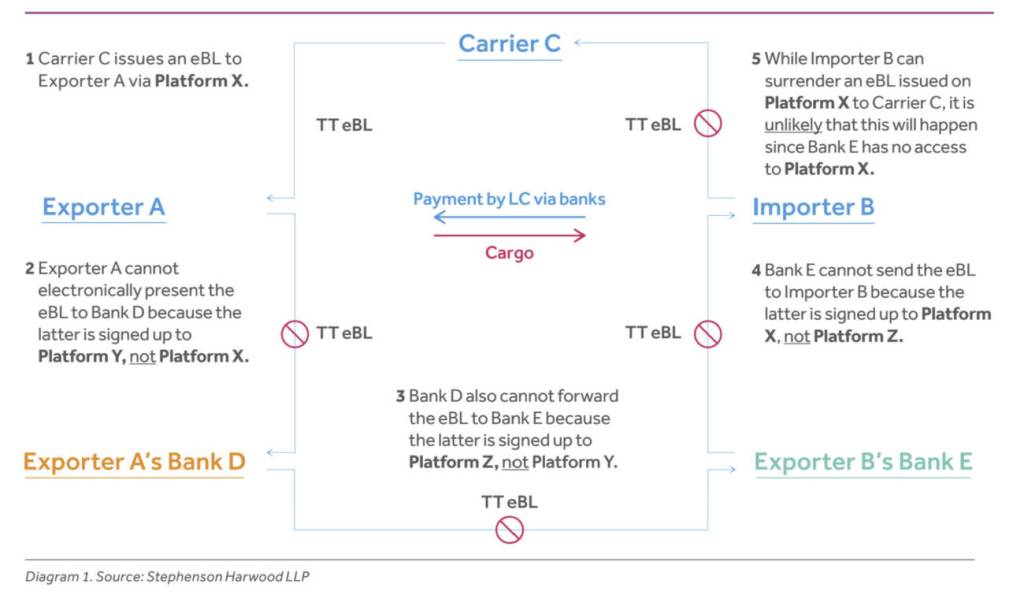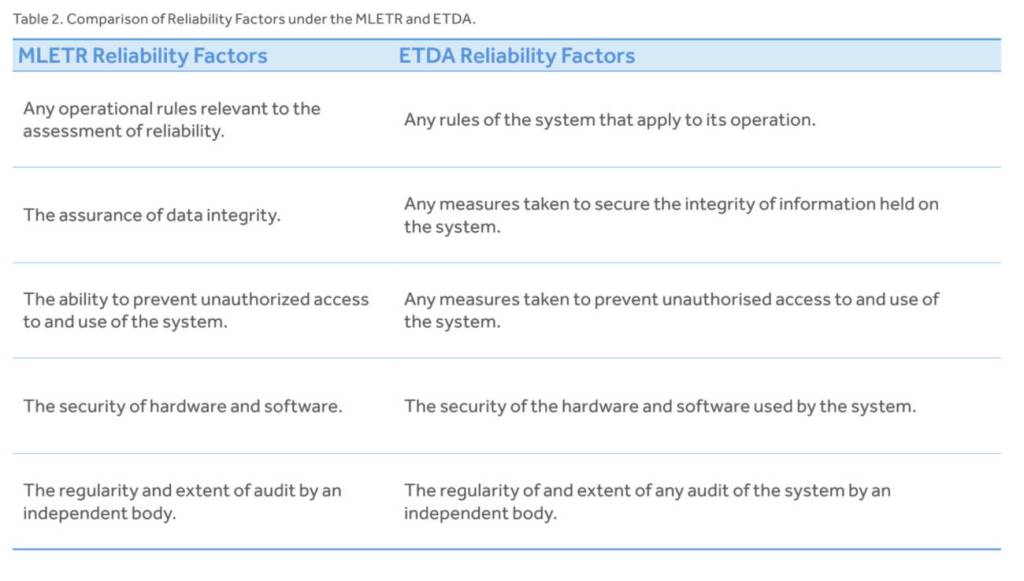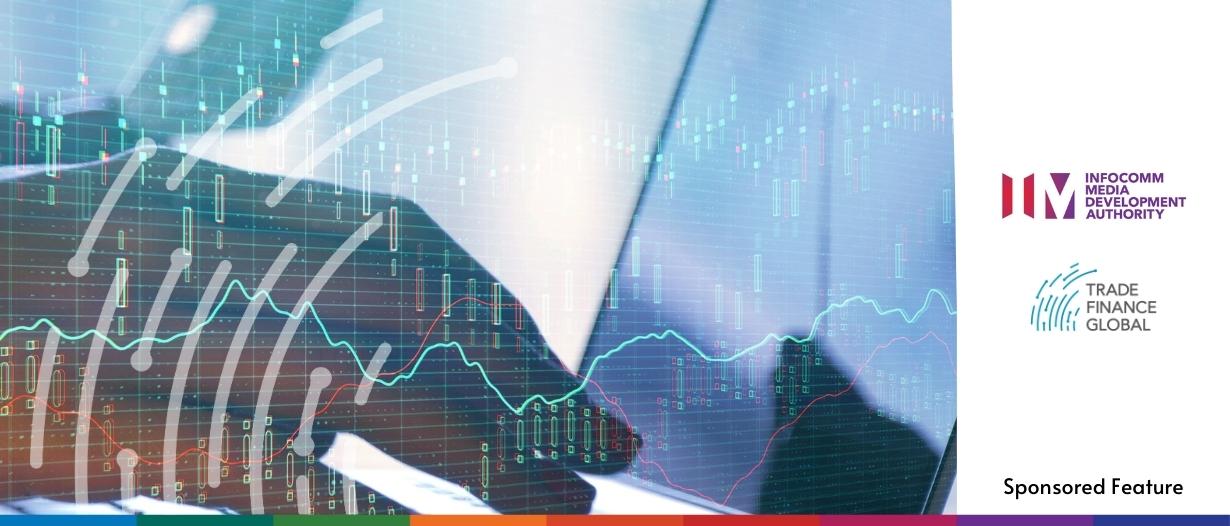Estimated reading time: 7 minutes
With over 2,000 years of history, it’s little wonder that paper lingers as the primary medium for trade document exchange despite the clear potential that digital alternatives present.
To help drive digital adoption in trade, Stephenson Harwood, in alliance with Virtus Law LLP, has collaborated with Singapore’s Infocomm Media Development Authority (IMDA) to release an article, TradeTrust-enabled Electronic Bills of Lading – A legal and practical analysis of their use in global trade.
To learn more about the article, the TradeTrust framework, and the broader implications for international trade and trade digitalisation, Trade Finance Global (TFG) spoke with representatives from the two organisations.
As it stands, the two most prevalent hindrances to digital adoption at scale – lack of legal and technical interoperability – appear to be compounded by a sense of industry fatigue.
eBL fatigue
The concept of an electronic bill of lading (eBL) has been around in its various forms for more than a quarter of a century and yet has not fully caught on.
Many of the early corporate proponents for eBL adoption found themselves forced to commit to a particular platform and merely hope that the one they selected would weather the digital storm and come out on the other side with a critical mass of other users.
Often, this was not the case, and those corporates found themselves hitched to a particular horse with nothing they could do but watch the value of their investment stagnate.
As trade digitalisation has become increasingly prominent in recent years, many of these same patterns have come to the fore on a broader scale. Once hyped platforms such as Marco Polo and we.trade have collapsed, leaving early adopters again burned.
Many observers are now hesitant to jump in early and find themselves again on the bleeding edge. Safer to wait for a clear winner to emerge before deciding which platform to support.
But with no first movers, there will be no movement.
Overcoming decades’ worth of fatigue will require a new approach that seeks to overcome the real, underlying challenges to eBL adoption.
Technical interoperability
While several platforms on the market provide legally compliant electronic bill of lading (eBL) or electronic trade document solutions, they often still impose a degree of platform dependence.
Though this makes excellent business sense from the platform perspective – requiring parties to remain within their ecosystem – it reduces the utility for nearly every other participant, including carriers, traders, and banks, as seen in the diagram below.

The Stephenson Harwood article notes that “these features have restricted the extent to which eBLs are able to replicate paper BLs, which in spite of their inefficiencies and drawbacks can be transferred freely across jurisdictions and beyond the immediate contracting parties.”
The way forward is to achieve a degree of technical interoperability by design that will integrate the best attributes of paper documents with the best attributes of electronic documents.
Loh Sin Yong, Director, TradeTrust, IMDA said, “If we are to have any chance of making trade paperless at scale, we’ve got to make it as open, interoperable and neutral as paper!”
This desire for neutrality and interoperability has prompted a new approach using an open framework design.
Trust in an open-source solution
The TradeTrust solution is an open-source digital framework and solution developed by Singapore’s IMDA.
By leveraging blockchain technology to create non-fungible tokens (NFTs) representing title ownership of an eBL, the digital solution can replicate the core functionalities of paper BLs, namely evidence of the contract of carriage, receipt for goods, and document of title.
The open-source nature of the solution allows transaction stakeholders to vet the code to ensure it does not do anything they would not want it to do, reducing data privacy and security concerns.
Perhaps most importantly, it also allows stakeholders to remain within their own digital environment while transacting with counterparts, eliminating the need for all involved to register and pay fees on a common platform.
Kay Ren Yuh, Assistant Director – TradeTrust, IMDA, said, “The TradeTrust software components sit in their system. It’s their bill of lading with their business partner. We are not in there in any way. TradeTrust isn’t a system that users ‘come to’ in the conventional sense.”
To facilitate smoother transactions, TradeTrust is “payload-agnostic”, and is compatible with DCSA and BIMCO standards around JSON, XML, and standardised semantics.
Establishing and maintaining this sense of trust is vital to achieving widespread adoption and, ultimately, economies of scale. As with any digital framework, the complete utility will not be realised until a critical mass of organisations are operational with the solution.
Once these early adopters are numerous enough to activate a flywheel effect, the solution will continue to grow organically and, potentially, exponentially. This will only serve to increase the value to new joiners and established parties alike.
Legal recognition for electronic trade documents around the world
The need for interoperability, however, is not just a technical one. Legal interoperability is also crucial. In this regard, trust plays a pivotal role in recognising and accepting eBLs in the shipping industry, encompassing legal recognition, insurance coverage, and the ability to convert eBLs into traditional paper forms when necessary.

Some jurisdictions may not acknowledge eBLs as valid bills of lading, potentially posing legal risks and slashing the solution’s utility. Furthermore, it will only be useful if it is able to fulfil the requirements of the law chosen for a transaction.
This means that the technical features of a system should be aimed at compliance with the criteria for electronic transferable records established by the United Nations Commission on International Trade Law’s (UNCITRAL) Model Law on Electronic Transferable Records (MLETR).
This would allow the parties to a transaction using such a digital system to select an MLETR-aligned governing law, which helps ensure consistent legal treatment and recognition.
Since around 80% of all maritime bills are governed under UK law, with the remainder primarily falling under the laws of various US jurisdictions, there is a significant opportunity to address this large market – particularly given the UK’s enactment of the MLETR-aligned Electronic Trade Documents Act (ETDA).
Stephenson Harwood said, “The ETDA effectively elevates eBLs to the same legal status as paper BLs and confers possessory rights on its holders. This significantly narrows the gap which stood in the way of wider uptake due to concerns over the legal recognition of eBLs.”

It’s not just the UK. Other jurisdictions, such as New York, Delaware, and Singapore, also provide the legal standing to use these tools effectively.
An eBL refresh
If eBLs are causing fatigue, it’s time for a fresh approach, and the TradeTrust framework provides a new way of approaching the challenges at play.
In August, the G20 Trade and Investment Ministers released a set of high-level principles for digitalising trade documents to help support a transition to paperless trade. The revived approach that TradeTrust provides through the release of its new framework adheres to each of the ten principles laid out by the G20.
Embracing the TradeTrust framework and design as a digital public good offers a promising path towards overcoming the obstacles of legal and technical interoperability in trade, ushering in a new era of efficient and secure digital trade document exchange.
Stephenson Harwood adds, “It has been a privilege to work with IMDA because TradeTrust it is an excellent example of how technological innovation and legal reform must work hand-in-hand as partners in digitalising global trade.”
To delve deeper into the TradeTrust digital framework and its implications for international trade, we invite you to download the full report from TradeTrust.io/legality. Alternatively, take this opportunity to begin adopting the digitalisation framework for yourself and start experiencing the advantages of trade digitalisation firsthand.
Your participation can be a catalyst for the transformation of global trade.























